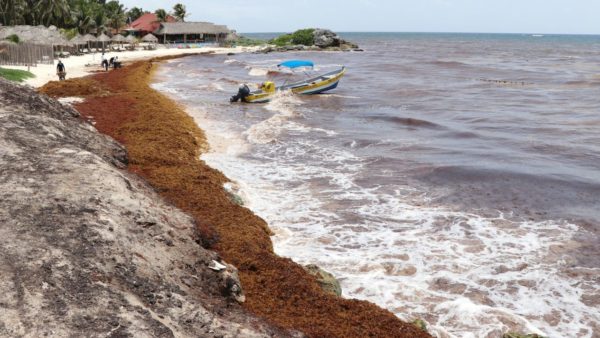The company Comercializadora Chaktumen of Quintana Roo S of R.L de C.V, which represents the company Ar.Co, announced that the installation of the 27 kilometers of barriers that will stop the arrival of sargassum to the coasts of the state, will begin on Thursday, August 23.
It was announced that the works will not be limited only to the placement of the barriers, but also permanent cleaning, collection and conduction of the organic material towards the ground will be carried out, with vehicles equipped with vacuum suction quipment to capture the algae without affecting the marine fauna.
The company indicated that sargassum could be used in the production of biodiesel and derivatives, as is sought by the Higher Technological Institute of Felipe Carrillo Puerto, as well as other institutions.
Among the critical points where the anti-sargassum barrier will be placed is the old town of Playa del Carmen to the south of Punta Venado, as well as in the municipalities of Benito Juarez (Cancun), Puerto Morelos, Tulum and Mahahual, although the exact location has not been decided yet.
The 27 kilometers that will comprise the containment meshes are not continuous, but will be placed by sections of 500 or 1,000 meters in front of the most affected beaches. The set of stretches deployed total the 27 kilometers contracted by the state government. Once the zones have been defined, the first mesh will be placed parallel to the most affected beaches.
Alfredo Arellano Guillermo, Secretary of Ecology and Environment (SEMA), announced that from June 19 to August 21, 134,592 cubic meters of sargassum have been collected.
Vacuum suction units will capture the algae from the shore of the beach and up to 15 or 30 meters offshore for complete cleaning.
The seaweed will be deposited on a flat bottom boat or vessel that is used for transport in shallow waters to carry them to land, be loaded in collection trucks that will take it towards its final confinement.
The second phase of the process will be carried out 250 meters away from the first barrier, that is, offshore. On this site, the same cleaning procedure will be carried out with the boats sucking the sargassum and depositing it in the barges.
Beyond the second barrier, more vacuum suction vessels will be deployed, practically in open sea, where they will capture as much sargassum as possible, before it reaches the beach.
TYT Newsroom with information from elfinanciero.com.mx



